Introduction
The Italian participation to World War I confirmed that the Regia Marina was ready and well trained despite the fact that, due to the will of the Allies, the fruits of victory had been limited. Italian successes were mostly the result of a complete control of the sea and continuous actions of defense and offense conducted under the command of the “Duca degli Abruzzi” and Admiral Thaon de Revel. The peace treaty of 1919 radically changed the balance in the Mediterranean, and although it had given Italy a better position in the Adriatic, it also created a delicate situation in the Mediterranean. This was mostly due to the new French expansions in Morocco and Syria, and the British control over Gibraltar, Egypt and Palestine.
After the failed Naval Conference of Geneva in 1932, where Italy had sought parity with the strongest European continental navy (France), the situation changed due to the Anglo-German and Anglo-Soviet agreements along with changes in Japanese naval policy. Thereafter, the international agreement of naval limitation expired and a period of limitation (Naval Holiday) was followed by almost complete freedom thus causing an escalation in naval rearmament. At this point, even the Italian Navy gave an impetuous boost to new constructions; still it was not allowed to develop the armament which would have most impacted the upcoming conflict: naval aviation. The war in Ethiopia demanded a great effort from the Regia Marina; not much in terms of combat but in logistics. This period of crisis, especially the one with Great Britain, demonstrated the importance of the naval affairs in the life of a country which had expanded to overseas dominions but who was still dependant on the British-controlled Suez canal. This situation should have suggested a different and more appropriate policy, instead it laid the tragic foundations of World War II where naval affairs were to have a great influence. Between 1922 and 1925, the Regia Marina reorganized incorporating German and Austrian ships captured during or obtained after the war, while keeping into consideration the limitations imposed by the Treaty of Washington (1921-22).
After having radiated the older units, the Regia Marina restarted the construction program under a plan originally started by Grand Admiral Thaon de Ravel and continued by Admiral Sirianni. Taking advantage of the progress made in the area of naval contraction during the previous conflict, the first round consisted in the manufacturing of torpedo boats for which the Treaty of Washington had set no limits. Great innovations were introduced in the area of propulsion. Engines, by this time fueled by oil, implemented super heated steam and turbines thus greatly increasing power and capable of obtaining over 30,000 H.P. per axle. At the same time, great developments took place in the area of diesel engines for both surface and submerged vessels. In the field of armaments, all units began installing anti-aircraft guns, while the new 533 mm (21”) torpedo became the standard. Catapults appeared on larger units for the deployment of hydroplanes to be used for tactical reconnaissance and the observation of gunnery. Special attentions were dedicated to the protection of battleships against underwater attacks. In 1932, having completed the first round of constructions, the Regia Marina allowed for the deployment of heavy cruisers of the “Trento” and “Zara” class and light cruisers of the “Condottieri” class.
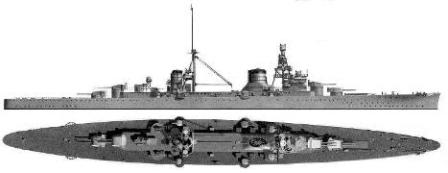
Trento Class
Also, during this period, began the construction of the destroyers of the “Sella”, “Sauro”, “Turbine” and “Freccia” class and the submarines of the “Balilla”, “Mameli”, “Vector Pisani” and “Argonauta” class. The first large cruisers of the “Washington” class (10,000 British tons and 8” guns) were the “Trento”. Designed and built for speed (this obtained at the price of protection), they were equipped with a light armor belt, while the similarly built French vessels had no protection at all. The Italian “10,000” which took to the sea after the “Trentos” were the “Zara”, units these with greater protection and lesser speed. This class was the best “Washington” built by Italy and had a harmonious balance of armament and protection. The fact that the enemy, in particularly advantageous circumstances, sank three of these units should not diminish their value. For the sake of speed, protection was completely sacrificed on the light cruisers of the “Da Giussano” class. Designed by Rota, these ships were initially designated as “Esploratori” (scout). In 1932, due to the failure of the Conference of Geneva for the limitation and control of the armament, Italy was forced to speed up the strengthening of her Navy. Starting in 1933, to partially reduce its inferiority respect to the French Navy, the Navy decided to radically rebuild the battleships Cesare, Cavour, Duilio and Doria, all veterans of World War I. In 1934-38, as a result of the building up in the international political situation, Italy began the construction of four modern battleships; fast and well armed they were named Vittorio Veneto, Littorio, Roma, and Impero.
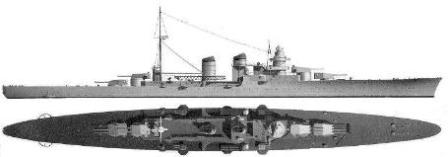
Duca degli Abruzzi Class
While the core of the fleet was been rebuilt, Italy placed into service cruisers, and numerous destroyers, torpedo boats and submarines. The last of the sever “10,000”, the Bolzano, was based on the Trentos, but it had much improved characteristics. A clear improvement over the first cruisers of the “Condottieri” class, was the release into service of the units type “Montecuccoli” and “Duca d’Aosta”. Even better were the two “Duca degli Abruzzi”, which during the period 1940-43 proofed themselves strong and with excellent performances. The last improved version of the cruiser class “Condottieri” was not completed, due to the bad turn taken by the war. The Ciano and Venezia would have been based on the “Duca degli Abruzzi” class, thus bringing the total number of light cruisers built by the Regia Marina between the two wars to fourteen. In 1939-40 began the construction of 12 cruisers of the class “Capitani Romani”; ships these with characteristics similar to the “grandi esploratori” (super destroyers) and equipped with efficient anti-torpedo boat and anti-aircraft armament. Constructions of these units were delayed due to the shortage of raw materials during the war, and up to September 8th, 1943, only three units (Attilio Regolo, Scipione Africano, Pompeo Magno) had entered service. In conclusion, the Regia Marina, which had planned to complete its building programs in 1942, entered the war on June 10th, 1940 with about 700,000 tons including 19 modern cruisers, for what was to be the harsh testing ground of World War II.
Heavy Cruisers
In June 1940 the Regia Marina, as it did with its battleships, entered the war with a fleet of relatevely new cruisers. There were still the old San Giorgio, Bari and Taranto (ex Pillau , and ex Strassburg received from the Germans after WW I), but all other units were of the kinds contemplated by the Treaty of Washington. The heavy cruisers had a displacement of 10,000 tons and were armed with guns up to 203 mm (8in); light cruisers had a displacement ranging from 5000 to 9000 tons and guns up to 152 mm (6in).
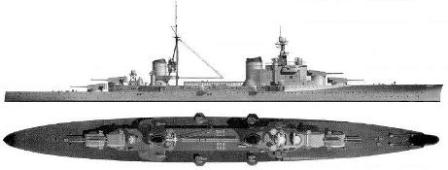
Bolzano Class
Initially, the Regia Marina followed the trends set by other navies, especially the French one, building the 10,000 tons Trento and Trieste placing more emphasis on speed to the decrement of armor.
The Italian heavy cruisers were built in only two classes: 3 units of the Trento class with 4 propellers and 150,000 HP, and 4 units of the Zara Class with only two propellers and 95,000 HP, but a much heavier armor, almost twice as thick as the one on the Trentos. It is to be noted that the Bolzano, even though like the Trento class had 4 propellers and 150,000 HP, was a much improved version of this class and it took advantage of the operational experience acquired between 1925 and 1930.
Both heavy and light cruisers were equipped with torpedoes at exemption of the Zara class. The Trento class had 4 double launchers in fixed installations. The catapults for airplanes on the Trento, Zara were fixed and place on the most forward part of the bow, while the Bolzano had a single catapult installed between the two funnels.
Zara Class
While the “Trento” class (Trento and Trieste) was still under construction, within the high command Regia Marina dissent began to mount over the choices made during the design phase. Specifically, critics complained that the new cruisers, despite their large displacement (10,000 t, as mandate by the Treaty of Washington, also known as the Five-Power Treaty), were too lightly protected. In essence, protection had been too greatly sacrificed to the benefit of speed: a remarkable 35.6 knots during the 1929 trials. Still the actual operation speed was limited to about 31 knots.
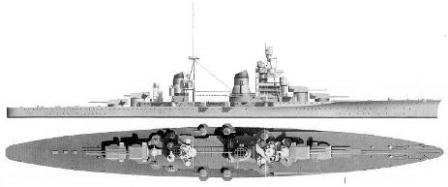
Zara Class
The first heavy cruiser class, the Trento, as well as the later Zara, were the result of an obsession with speed that dated back almost 70 years and that drove the Italian ships to always being a few knots faster than their foreign counterparts. It should be considered that during this period the Regia Marina did not have any operational battleship, thus these heavy cruisers, at least while the older battleships were being rebuilt and the new one built, represented the core of the fleet. Thus, the new cruiser had to be equipped with substantial armor, 200 mm, and the most powerful guns, 203 mm (8”), allowed by the treaty.
Having received a secretive consent from the head of government and the high hierarchy of the Navy to proceed with a project which would exceed the limit set forth by the aforementioned treaty, the “Comitati Progetto Navi” (the bureau in charge of naval constructions) produced a new design. Notwithstanding the original desired requirements, weight limitation (there was a limit to cheating after all) forced a reduction of the armor to 150 mm for the vertical surfaces and 70 mm for the horizontal ones. The main armament was kept at 8, 203 mm guns (8”) but the power plan was reduced from 150,000 to 95,000 HP. Still, the maximum trial speed ranged between 32.9 and 35.2 knots, while the final operational speed equaled the one of the Trento Class at about 31 knots. This high speed was mostly due to the power plan exceeding the requirements set forth by the construction specification by well over 23,000 HP. Thus, the true power for this class should be rated at about 118,000 HP. Most sources still report 95,000 HP.
Unlike the two Trento Class, and later the R.N. Bolzano, which had four shafts, the Zara Class had only two shafts. The Zara Class had eight boilers of the Thornycroft 3-drum type. Two groups of Parsons type, OTO-built, geared turbines moved two three-blade propellers.
At the end, the Regia Marina was to have a total of seven heavy cruisers that, despite their difference in design, could operate jointly. The first of the four new heavy cruisers of this class was the Fiume (build in Trieste), followed by the Zara (La Spezia), and then the Gorizia and Pola (Leghorn). The class was named after four provinces in the Italian northeast (Venezia Giulia). Fiume, Pola and Zara had been added to the territory in 1924, while Gorizia was created in 1927. After the war, all but the last one were lost to Yugoslavia (later Slovenia and Croatia) and renamed Rijeka, Pula and Zadar.
On the Zara class the armor was thick enough to withstand hits from guns equal to her own (they were designed to fight directly other heavy cruisers), resulting in the best armored cruisers in the world at the time. This was an important achievement because the standard for many of the Washington Treaty cruiser was a much lighter armor belt, and even less armor for the turrets and barbettes. Theorists assume that a 150 mm armor plate was not enough to withstand an incoming 203 mm armor piercing naval shell; this theory was never tested on these ships, but during the war, lighter British cruisers kept their distance from these frightening engineering marvels.
To achieve this improved armor, the Zaras were almost 2000 t heavier (as standard displacement) than the limit set forth by the treaty. In addition to the armored main belt, up to 150mm thick, there was also a very thick main deck armor of up to 70mm. Turrets and barbettes were also protected by 100mm armor. In addition to this armor, there was even another series of minor armors: the upper deck was 20mm, and the flank hull above main belt was 30mm. Almost no other cruisers were equipped with two armored decks and two armored belts. This design followed, in fact, not quite a cruiser scheme, but rather the one of a small battleship. A somewhat similar design was later implemented on the Littorio class with the introduction of de-cupping plates. Of course, this was only possible by ignoring the treaty limitations under which other constructors operated with their 203mm cruisers. Only the Des Moines class ended up having heavier armor than the Zara, but these were 17,000 tons units.
)In 1943, the only surviving unit, the R.N. Gorizia, was hit by three bombs launched by American heavy bombers. The main deck resisted the blasts and the ship continued firing during the whole bombardment. This is the only realistic test of the effectiveness of the Zara Class armor since the other three units were lost in the Battle of Matapan in extremely unusual circumstances.
The Zaras were equipped with the new Ansaldo 203 mm 53 caliber guns, models 1927 and 1929. These guns were superior to the Trento 203/50 for rate of fire, but shared the same salvo dispersion issues. While the 203/50s were produced by Ansaldo under industrial agreements with Schneider of France, the new 203/53 were a home-grown project. The projectile’s speed, originally at 930 m/s, was later reduced to 900 m/s to address serious dispersion issues, in addition to an unusually high barrel wear (this was common to many Italian naval guns). Thus, the original range of 31.5 km was also reduced to 29 km. Each turret hosted two guns each with an independent ammunition loading system. The guns could be loaded while elevated, thus increasing the rate of fire. The secondary armament was identical to the previous class of heavy cruisers and consisted of 12 100/47 and 2 120/15. There were also some 8 37/5 and 8 13.2 machine guns. Later, some of the 100/47s were replaced with 37/54 to be used against aircrafts. In general, anti-aircraft protection remained weak.
What might have appeared as an odd design, the installation of an airplane catapult on the aft desk, was instead a well thought out compromise. Since the aircrafts on board were to provide a spotting, rather than defense service, it was not considered useful to be able to catapult planes while the forward guns were in use. Furthermore, the launching of the plane required the ship to be steered into the wind, thus making this operation almost impossible during combat. Initially the Zara received two Piaggio P6 bis reconnaissance seaplanes, later replaced by M41s, then Cant 25 ARs, then M.F.6s, and finally (1938) by Ro. 43s.
At the time of their construction, the Italian Navy did not have radar equipment, thus these ships were not equipped with any such apparatus. Possibly, the Gorizia received one of these installations of the Gufo type around 1943. Fiume and Zara were quite similar, while the Gorizia had a taller and wider forward funnel. The silhouette of the Pola was quite recognizable having the forward funnel integrated with the bridge structure.
At the beginning of the conflict, these four cruisers made up the 1st Cruiser Division which formed the more important squadron of the Regia Marina. The Zara, Gorizia, and Fiume participated in the Battle of Punta Stilo. The Pola, Fiume and Gorizia participated in the Battle of Cape Teulada. As commonly known, all but the Gorizia were lost during the Battle of Matapan. Thereafter, the Gorizia was grouped with the Trento Class units and participated in all major engagements and battles of the Mediterranean. After the already mentioned American bombardment of the Gorizia on April 10th, 1943 in the port of La Maddalena (Sardinia), the unit was sent to La Spezia for repairs and never reentered service. Sabotaged by an Anglo-Italian group of frogmen, its hull was found at the end of the conflict, semi submerged, in the harbor of La Spezia.
Light Cruisers
In June 1940 the Regia Marina, as it did with its battleships, entered the war with a fleet of completely renovated cruisers. There were still the old San Giorgio, Bari and Taranto (ex Pillau , and ex Strassburg received from the Germans after WW I), but all other units were of the kinds contemplated by the Treaty of Washington. The heavy cruisers had a displacement of 10,000 tons and were armed with guns up to 203 mm (8in); light cruisers had a displacement ranging from 5000 to 9000 tons and guns up to 152 mm (6in).
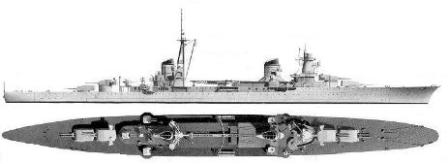
Montecuccoli Class
The light cruisers included four different types, the so called “5000” of the Condottieri class, the “7000” of the Montecuccoli class, the “8000” of the Eugenio di Savoia class to end with the “9000” of the Garibaldi class. During the construction of the first “5000”, the four Di Giussano, Da Barbiano, Colleoni and Bande Nere, as with the Trento, focus was almost exclusively given to speed. Therefore, these units had power plant of 95,000 HP similar to the 10,000 ton Zara class, which propelled these units up to 37 knots. Consequently, armor was very light with only 20-24 mm, completely inadequate to protect the vital organs of the ship against guns of 152 mm of which they were armed. Furthermore, due to the absence of underwater protection, all four units were sunk by enemy attack by means of torpedoes.
The “7,000” of the Montecuccoli class represented an improvement over the “5000”, but shared the same structural deficiencies with the Attendolo loosing its bow to a torpedo attack , and then being sunk in Naples by aerial bombardment. Definitely improved were the subsequent Duca d’Aosta and Eugenio di Savoia and finally the two Garibaldi and Duca degli Abruzzi which represented the completion of the evolution of the Italian light cruiser reaching 10,000 tons and an armament of 10 152mm guns while all other units had only 8. Both heavy and light cruisers were equipped with torpedoes at exemption of the Zara class. The light cruisers of the Condottieri class had 4 double launchers in trainable installations placed on deck near the stern smokestack. Similar layout was present on the Montecuccoli class, but with the launchers placed slighter more forward, at about half way between the two smokestacks.
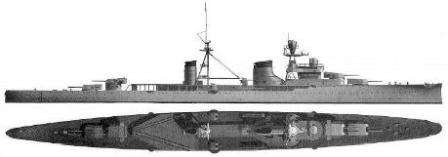
The Cadorna Class
The Duca d’Aosta and the Garibaldi had instead only 6 launchers in two triple-complexes, placed in the same location on deck. The catapults for airplanes on Di Giussano class were fixed and place on the most forward part of the bow. Instead, the Cadorna, Montecuccoli and the Duca d’Aosta had movable catapults placed between or behind the smokestacks. Finally, the Garibaldi had two catapults placed behind the stern smoke stack.
During the war, the Regia Marina laid down 12 light cruisers of the Attilio Regolo (or Capitani Romani) class, but by September 8, 1943 only three, Attilio Regolo, Pompeo Magno and Scipione Africano had entered service. The remaining units were either scraped or captured by the Germans.
Two anti-aircraft cruisers, the Etna and the Vesuvio were built transforming two units ordered by Siam from the Cantieri Riuniti dell’Adriatico, but never entered service. During the war, the Regia Marina incorporated two French cruisers captured in Toulon, the FR 11, Jean De Vienne, and the FR 12, La Galissonlère but they never entered service.